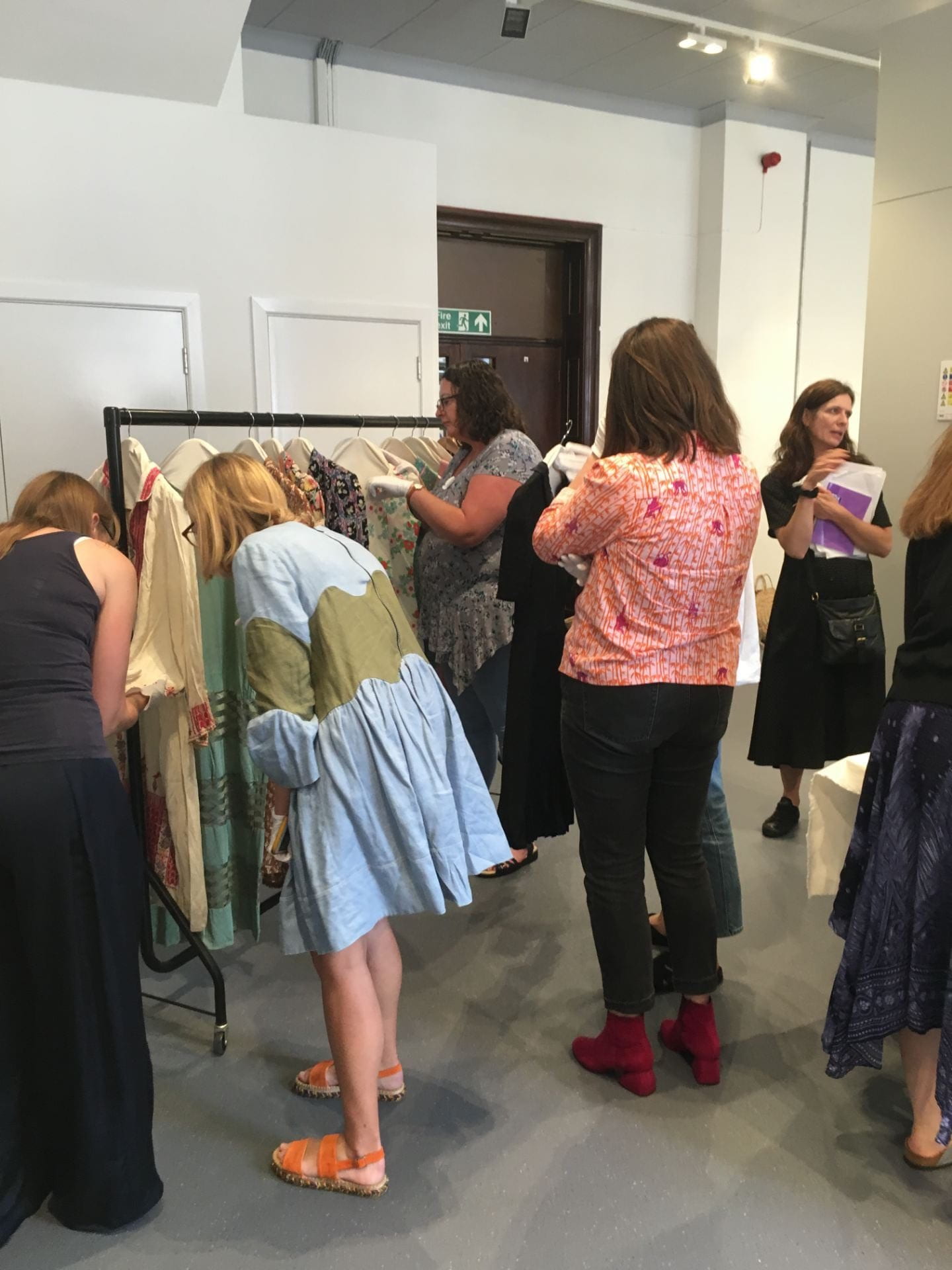Suzanne Rowland, PhD student at the University of Brighton, describes a collaborative event at Worthing Museum.
On 5 July 2019 a joint study day took place between members of the University of Brighton research group Objects Unwrapped and the Fashion Research Network (FRN) at Worthing Museum and Art Gallery (WMAG). Material Lives: Methodologies for Researching the Histories of Everyday Dress was generously funded by the Centre for Design History and organised by Objects Unwrapped members Dr Cheryl Roberts, Dr Jenny Richardson and Dr Hannah Rumball and doctoral students Alex Esculapio and Suzanne Rowland, with Dr Bethan Bide from University of Leeds representing the FRN. 18 participants attended, including BA, MA, and PhD students from the University of Brighton.
The morning session began with an introduction to the museum’s large collection of everyday dress from Museum Manager and Curator of Costume and Textiles, Gerry Connolly. The museum’s new Costume Study Centre was the next subject for discussion. Financed by the Heritage Lottery Fund and local authority, the centre is part of the museum’s ongoing restructuring programme titled ‘Let the Light in’ which aims to make use of the museums many under-used spaces. The Costume Study Centre will not be fully open to researchers until September 2019, so we were privileged to be the first group to use it as part of our afternoon object handling session. The morning progressed with introductions to Objects Unwrapped and to the Fashion Research Network by Suzanne Rowland and Bethan Bide, with all participants warmly invited to join both groups.
Presentations followed from AHRC Techne-funded PhD students – Jo Lance and Kate Debono, both collaborating with Worthing Museum. Jo Lance used a fascinating collection of home-made hats to illustrate how she intends to approach her PhD project. To give just one example, by using sewing patterns from the 1930s from the museum’s collection, Jo intends to run workshops and invite participants to test these patterns and instructions. An enthusiastic discussion of this project by participants followed.
Kate Debono then explained her attraction to ‘ambiguous objects’ before revealing the subject of her forthcoming Objects Unwrapped essay – a pair of worn jersey leggings dating from the early 1990s. Kate took us on a fascinating journey which ably demonstrated the value of material culture research, encompassing the development of Lycra alongside a history of high street fashion retailer New Look. Kate concluded by connecting the leggings to her own experiences of wearing a similar pair and left us to think about the evocative nature of memory in relation to everyday dress.
Bethan Bide’s reading group focused on a single journal article: Hunt, C. ‘Worn Clothes and Textiles as Archives of Memory.’ Critical Studies in Fashion & Beauty 5, no. 2 (2014): 207-232. Bethan told us of discussions she had been involved with at the Museum of London relating to how best to display everyday objects in the new galleries. She had looked to the Hunt article to consider whether the idea of clothing as carriers of memories can be used in museums, and then opened this thought out to our study day participants. This led to a discussion about the sensory experiences of changing rooms which included smells and the discomfort over lack of privacy. We also discussed whether museums should collect oral histories which included conflicting opinions both for and against.
The afternoon reading group was based on two readings selected by Alex Esculapio: Buckley, Cheryl and Clark, Hazel. “Conceptualizing Fashion in Everyday Lives.” Design Issues, 28:4 (2012) 18-28, and Harden, Rosemary. “From Museum of Costume to Fashion Museum: The Case of the Fashion Museum in Bath.” Marie Riegels Melchior and Birgitta Svensson (eds.) Fashion and Museums: Theory and Practice (London and New York: Bloomsbury, 2014) 127-38. Alex asked us to consider place and space which helped to pull together ideas surrounding the display of everyday dress. WMAG’s Costume Trail was cited as a particularly successfully example of everyday dress in an outreach setting.
The object handling session then took place in the shiny new, and still-smelling-of-fresh-paint, Costume Study Centre. Examples of everyday dress on show included daywear, hats and shoes from the 1920s, 1940s and 1960s. Participants were asked which objects spoke to them and PhD student Jo Pilcher cited a pair of winkle pickers with toe imprints from the wearer embedded in the insoles.
Finally, we discussed ways to take the study day forward and to broaden our scope towards community engagement. Ideas included inviting several people to look at a single garment to ensure a triangulation of voices, this might include those with memories wearing similar garments, makers, curators, academics, and students. It was also suggested that the format for the study day could be applied to other collections both nationally and regionally. There was a strong sense of wanting to be inclusive and in recognising different types of value in relation to everyday dress, and of bridging the gap between those who feel separated from museum and academic communities.







Leave a Reply